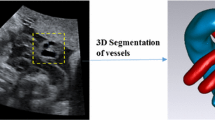Abstract
Various empirical indices such as the pulsatility index (PI) are widely used for quantitative analysis of Doppler ultrasound velocity waveforms. The physical interpretation of these indices was studied using a mathematical model. Although the method has more general applicability, this particular study was concerned with the umbilical-placental circulation. A lumped element electrical circuit equivalent was used, with each arterial branch represented by a resistor and a capacitor. The placental villous bed was modelled by a two-step parallel branching structure. Placental vascular disease was modelled either as obliteration of a fraction of the terminal branches, or as a fractional decrease in the radius of the vessels. The main features of both normal and abnormal umbilical artery waveforms can be reproduced by this simple model. Theoretical relationships between the velocity waveform indices and the lumped resistances and capacitance of the system were obtained for different input pressure functions. Over a wide range of physically reasonable conditions, the umbilical artery PI is approximately proportional to the ratio of the placental resistance to the umbilial artery resistance. The PI also depends on the pulsatility of the input pressure waveform. The Fourier pulsatility index was evaluated for an arbitrary pressure function, and shown to behave like (PI)2 for the umbilical artery waveform.
Similar content being viewed by others
References
Caro, C. G., Pedley, T. J. Schroter, C. W. andSeed, W. A. (1978)The mechanics, of the circulation. Oxford University Press, Oxford.
Erskine, R. L. A. andRitchie, J. W. K. (1985) Umbilical artery blood flow characteristics in normal and growth retarded fetuses.Br. J. Obstet. & Gynaecol. 92, 605–610.
Fox, H. (1978)Pathology of the placenta, W. B. Saunders, London.
Giles, W. B., Trudinger, B. J. andBaird, P. J. (1985) Foetal umbilical artery flow velocity waveforms and placental resistance: pathological correlation.Br. J. Obstet. & Gynaecol.,92, 31–38.
Gill, R. W., Trudinger, B. J., Garrett, W. J. Kossoff, G., andWarren, P. S. (1981) Fetal umbilical venous flow measured in utero by pulsed Doppler with B mode ultrasound.Am. J. Obstet. Gynecol.,139, 720–725.
Johnston, K. W., Kassam, M., Koers, J., Cobbold, R. S. C. andMacHattie, D. (1984) Comparative study of four methods for quantifying Doppler ultrasound waveforms from the femoral artery.Ultrasound in Med. & Biol. 10, 1–12.
Ku, D. N. Giddens, D. P., Phillips, D. J. andStrandness, D. E. (1985) Hemodynamics of the normal human carotid bifurcation: in vitro and in vivo studies.,11, 13–26.
Meara, L. A. (1984) Pole-zero extraction by nonlinear regression of discrete-time arterial blood-flow waveforms.Med. & Biol. Eng. & Comput.,22, 281–284.
Mulders, L. G. M., Wijn, P. F. F., Jongsma, H. W. andHein, P. R. (1987) A comparative study of three indices of umbilical blood flow in relation to prediction of growth retardation.J. Perinat. Med. 15, 3–12.
Skalak, R. (1972). Synthesis of a complete circulation. InCardiovascular fluid dynamics, Vol. 2.Bergel, D. H. (Ed.), Academic Press, London.
Skidmore, R. andWoodcock, J. P. (1980) Physiological interpretation of Doppler shift waveforms. I. Theoretical considerations.Ultrasound in Med. & Biol.,6, 7–10.
Thompson, R. S., Trudinger, B. J. andCook, C. M. (1986a) A comparison of Doppler ultrasound waveform indices in the umbilical artery. I. Indices derived from the maximum velocity waveform.,12, 835–844.
Thompson, R. S., Trudinger, B. J. andCook, C. M. (1986b) A comparison of Doppler ultrasound waveform indices in the umbilical artery. II. Indices derived from the mean velocity and first moment waveforms.,12, 845–854.
Thompson, R. S., Trudinger, B. J. andCook, C. M. (1988) Doppler ultrasound waveform indices. AB ratio, pulsatility index and Pourcelot ratio.Br. J. Obstet. &. Gynaecol. (in press).
Trudinger, B. J., Giles, W. B., Cook, C. M. Bombardieri, J. andCollins, L. (1985) Fetal umbilical artery flow velocity waveforms and placental resistance: clinical significance.,92, 23–30.
Womersley, J. R. (1955a) Oscillatory motion of a viscous liquid in a thin walled elastic tube. I. The linear approximation for long waves.Phil. Mag. 46, 199–221.
Womersley, J. R. (1955b) Method for the calculation of velocity, rate of flow and viscous drag in arteries when the pressure gradient is, known.J. Physiol. 127, 553–563.
Author information
Authors and Affiliations
Rights and permissions
About this article
Cite this article
Thompson, R.S., Stevens, R.J. Mathematical model for interpretation of doppler velocity waveform indices. Med. Biol. Eng. Comput. 27, 269–276 (1989). https://doi.org/10.1007/BF02441484
Received:
Accepted:
Issue Date:
DOI: https://doi.org/10.1007/BF02441484




